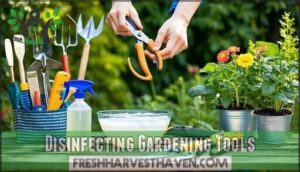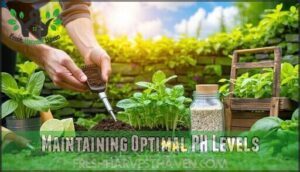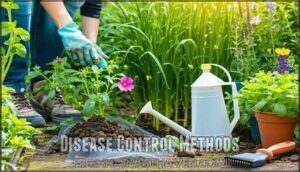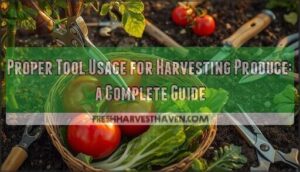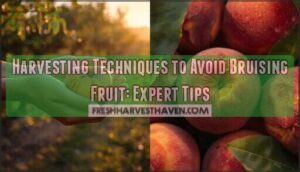This site is supported by our readers. We may earn a commission, at no cost to you, if you purchase through links.
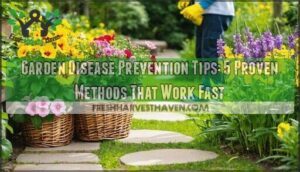 You’ll want to start with these essential garden disease prevention tips: rotate your crops every season to break disease cycles, choose disease-resistant plant varieties, and maintain proper soil drainage.
You’ll want to start with these essential garden disease prevention tips: rotate your crops every season to break disease cycles, choose disease-resistant plant varieties, and maintain proper soil drainage.
Keep your tools clean between plants—think of it as washing your hands between patients. Remove diseased plant debris immediately; it’s like eliminating breeding grounds for trouble.
Monitor plants weekly for early warning signs like yellowing leaves or unusual spots. Proper spacing guarantees good air circulation, while balanced fertilizing strengthens natural plant defenses.
These fundamentals create an invisible shield around your garden, but there’s a strategic timing element that can make or break your success.
Table Of Contents
- Key Takeaways
- Preventing Plant Diseases
- Garden Sanitation Tips
- Soil Health Management
- Disease Control Methods
- Timing Planting Strategically
- Frequently Asked Questions (FAQs)
- How do I prevent diseases in my garden?
- How to keep plant diseases away?
- How do I prevent pathogen buildup in my garden?
- How do you treat plant diseases effectively?
- Are garden diseases curable?
- Should you control a pathogen in your garden?
- What are the 5 principles of plant disease control?
- What is the best way for protection against plant disease?
- How to prevent plant disease symptoms?
- How to treat plant diseases organically?
- Conclusion
Key Takeaways
- Rotate your crops every 3-5 years – you’ll break disease cycles by forcing pathogens to starve when their preferred host plants aren’t available in the same soil spots
- Choose disease-resistant varieties – you’ll cut chemical spraying needs by 60% while boosting yields by selecting plants with built-in genetic protection against common pathogens
- Clean your tools between plants – you’ll prevent spreading diseases by wiping pruners and shears with rubbing alcohol, treating it like washing hands between patients
- Space plants properly and water at soil level – you’ll reduce fungal infections by 50% through improved airflow and prevent splash-back contamination by watering in the early morning at the base
Preventing Plant Diseases
You can’t prevent every plant disease, but smart prevention saves you from hours of frustration and crop loss later.
These five proven methods work by stopping problems before they start, giving your plants the best chance to thrive naturally.
Rotating Crops Regularly
Your crop rotation strategy disrupts disease cycles that thrive when the same plant families occupy identical soil spots year after year.
This garden disease prevention technique forces pathogens to starve without their preferred hosts, creating healthier growing conditions through seasonal planning and plant diversity.
Smart crop rotation benefits include:
- Breaking the pathogen party – disease organisms lose their food source when you switch plant families
- Giving your soil a fresh start – different root systems contribute unique nutrients during garden renewal
- Cutting disease rates dramatically – bacterial spot infections drop 67% with proper rotation intervals
- Building natural soil defenses – diverse plantings encourage beneficial microorganisms that outcompete harmful pathogens
Follow three-year intervals between planting the same families for maximum soil rejuvenation and disease prevention strategies.
Effective disease control methods are essential for maintaining healthy soil and preventing the spread of pathogens.
Using Disease-Resistant Cultivars
While crop rotation disrupts disease cycles, your choice of resistant varieties provides an even stronger defense. Disease resistant plants carry genetic traits that naturally repel specific pathogens, making plant disease prevention more reliable than environmental controls alone.
Cultivar selection starts with reading seed packets carefully. Look for resistance codes like "VFN" (Verticillium, Fusarium, Nematodes) or "PMR" (Powdery Mildew Resistant) that indicate built-in protection. Plant breeding has created varieties like ‘Defiant’ tomatoes, which resist late blight and Fusarium wilt, or ‘Picolino’ cucumbers with scab resistance.
| Crop | Disease-Resistant Variety | Protection Against |
|---|---|---|
| Tomato | ‘Mountain Pride’ VFN | Verticillium, Fusarium, Nematodes |
| Cucumber | ‘Suyo Long’ | Downy Mildew, Powdery Mildew |
| Squash | ‘Dunja’ PMR | Powdery Mildew |
| Bean | ‘Provider’ | Rust, Mosaic Virus |
| Pepper | ‘Revolution’ | Bacterial Spot, Phytophthora |
Disease tolerance varies by variety, so match your crop selection to local disease pressures. Diseaseresistant varieties reduce chemical spraying needs by up to 60% while increasing yields. Using disease resistant methods can help minimize the reliance on chemical sprays in gardens.
Balanced Fertilization Techniques
Beyond choosing resistant varieties, your fertilization strategy directly impacts plant immunity.
Proper nutrient balance strengthens cellular walls and boosts natural defenses against pathogens.
Balanced fertilization requires understanding soil conditions through testing.
Excess nitrogen creates soft, vulnerable tissue that diseases exploit easily.
Smart nutrient management focuses on timing and ratios.
- Test soil pH annually using digital meters for accurate nutrient availability readings
- Apply organic matter like compost to improve microbe management and soil structure
- Follow 3-1-2 NPK ratios for most vegetables using slow-release fertilizer types
- Time applications strategically based on plant growth stages rather than calendar schedules
Regular Monitoring for Pests
Through weekly pest inspection routines, you’ll spot trouble before it spreads throughout your garden.
Check plants for aphids, caterpillars, and spider mites during ideal detection windows.
Early insect monitoring prevents minor issues from becoming major headaches.
Implement trap crops like nasturtiums to lure pests away from your main plants.
Pest trapping methods work best when combined with biological control agents like beneficial insects.
This integrated pest management approach reduces chemical dependency while maintaining effective natural pest control.
Smart garden pest management means timing your inspections right.
Pest control becomes manageable when you catch problems early and use nature’s own solutions to keep your plants healthy.
Garden Sanitation Tips
Proper garden sanitation forms the foundation of effective disease prevention by eliminating pathogen sources before they can spread.
You’ll substantially reduce disease pressure by maintaining clean growing environments and following basic hygiene practices throughout the growing season, which helps in disease prevention.
Removing Old Crop Debris
Your garden’s health starts with a clean slate each season. Debris removal eliminates overwintering pathogens that cause next year’s headaches.
Pull up spent plants, rake fallen leaves, and clear all crop residue completely. This garden cleanliness practice breaks the disease prevention cycle before it starts.
Think of soil cleansing as insurance for your plants. Crop debris harbors soil borne diseases that spread through wind and rain.
Complete garden renewal through proper disease prevention methods and thorough garden sanitation sets you up for success. Effective garden rake tools are essential for removing debris and preventing disease.
Disinfecting Gardening Tools
Tool Sanitization protects your plants from spreading diseases between cuts and digs.
Clean pruners, shears, and trowels with rubbing alcohol or bleach solution after each use.
Equipment Cleaning takes seconds but prevents pathogens from hitchhiking between plants.
Sterilization Methods include wiping blades with Sanitizing Solutions or dipping in Cleaning Products.
Tool Disinfection stops bacterial and fungal infections cold.
Smart Equipment Cleaning means healthy plants and fewer headaches later.
Regular use of a Gardening Tool sanitizer is essential for effective garden disease prevention.
Cleaning Watering Systems
Your irrigation system can become a disease highway if you don’t maintain it properly. Contaminated water lines spread harmful pathogens throughout your garden, turning your watering system cleaning routine into critical plant protection.
A contaminated irrigation system turns your helpful watering routine into a disease-spreading nightmare.
A dirty watering system is like using the same tissue for every sneeze—it spreads problems everywhere.
Regular Drainage Systems maintenance and Sprinkler Maintenance prevent bacterial buildup that threatens plant health.
- Water Filter replacement every 3-6 months removes disease-causing contaminants from your water supply
- System flush with diluted bleach solution monthly eliminates bacteria lurking in water lines
- Pipe Cleaning removes stubborn biofilm deposits that harbor pathogens in irrigation systems
- Tank maintenance includes scrubbing walls and changing stagnant water regularly for superior water filtration
- Irrigation Management checks for clogs guarantee proper flow and prevent stagnant water breeding grounds
Proper irrigation techniques, including optimal watering times, are essential for maintaining a healthy garden ecosystem.
Soil Health Management
Your soil’s health determines whether pathogens thrive or struggle to establish in your garden.
Building strong soil structure with organic matter creates natural disease resistance while maintaining proper pH levels guarantees plants can access nutrients needed for robust immune systems, including the ability to establish a strong defense against pathogens with organic matter.
Adding Organic Matter
Your soil becomes a natural disease-fighting system when you add organic matter like compost and aged manure.
Compost benefits include boosting beneficial microbes that crowd out harmful pathogens. Soil amendments create stronger plant immunity through improved soil microbial health.
Natural gardening techniques using organic fertilizers reduce disease pressure substantially.
Amendment Type Disease Prevention Benefit
Improving Soil Structure
Creating soil structure starts with understanding how particles bond together.
You’ll need organic matter like compost and aged manure to form stable aggregates that hold water yet drain properly.
Soil aeration improves when you avoid heavy machinery and use garden forks instead.
Regular composting for health builds those vital air pockets roots need for healthy growth and disease resistance.
Maintaining Optimal PH Levels
Testing your garden’s pH levels reveals healthier plants and stronger disease resistance. Soil pH testing reveals nutrient availability, with most vegetables thriving between 6.0-7.0 where microbe balance flourishes and disease pressure drops.
Your pH balancing action plan:
- Test annually using calibrated soil kits or lab analysis for accuracy
- Apply lime (50 lbs per 1,000 sq ft) when acidic limits drop below 6.0
- Use sulfur (1-3 lbs per 100 sq ft) for alkaline soil pH corrections
- Wait patiently 3-12 months for lime application or sulfur application to stabilize
- Monitor progress as improved nutrient management boosts plant immunity
Understanding soil health basics is vital for maintaining ideal pH levels and overall garden health. Remember, rushing pH adjustments often backfires. Gradual changes create lasting soil health that naturally fights off diseases.
Disease Control Methods
When diseases threaten your garden, you’ll need targeted control methods that stop pathogens before they spread.
These three approaches—physical barriers, organic fungicides, and proper hygiene practices—work together to create multiple lines of defense against common plant diseases.
Using Physical Barriers
Through strategic placement, physical barriers create an invisible shield around your garden.
Row covers made from fine mesh allow sunlight and water penetration while blocking disease-carrying insects.
Copper strips around beds naturally repel slugs that spread bacterial infections.
Install reflective mulch to confuse aphids and reduce virus transmission.
Plant guards protect individual specimens from wind damage that creates pathogen entry points.
Trellises improve airflow, preventing moisture buildup that encourages fungal growth.
These barrier films work 24/7 without chemicals or maintenance.
Applying Organic Fungicides
Beyond simple prevention measures, organic fungicides offer targeted protection when fungal threats emerge. These natural solutions work by disrupting spore germination and creating protective barriers on plant surfaces, reducing disease incidence by up to 60% when applied preventively.
- Copper-based formulations: Copper hydroxide and copper octanoate effectively combat blights, leaf spots, and bacterial cankers
- Biological agents: Bacillus subtilis and Streptomyces lydicus provide broad-spectrum control against multiple pathogens
- Plant-derived oils: Neem and clove oils inhibit spore development while remaining bee-safe for pollinator protection
- Food-grade options: Potassium bicarbonate and citric acid formulations offer over 80% powdery mildew suppression
Apply fungicide sprays every 7-14 days during humid conditions, ensuring complete coverage including leaf undersides. These organic controls require consistent timing since they’re preventive rather than curative. Test on small areas first to avoid phytotoxicity on sensitive plants. For effective disease management, understanding organic fungicide options is essential for gardeners.
Practicing Good Hygiene
Your hands aren’t just dirty—they’re disease carriers. Clean tools between plants using rubbing alcohol to prevent pathogen transfer. Sanitize pots and containers before reuse to guarantee disease free environments.
Choose healthy transplants from reputable sources, and maintain sterile equipment throughout your gardening sessions.
pathogen transfer
barrier protection
plant health tips
These garden hygiene practices form your first defense against disease outbreaks. Proper tool sanitation and hand sanitizing create barriers that pathogens can’t cross.
Replace garden gloves regularly—they’re your shield. Good personal hygiene keeps your garden thriving.
Timing Planting Strategically
Timing your planting correctly prevents most garden diseases before they start. You’ll avoid weather stress that weakens plants and creates perfect conditions for pathogens to take hold.
Checking Frost Dates
Know your frost dates to protect plants from cold protection threats.
Frost risk varies by location – urban areas stay warmer while rural spots freeze earlier. Check local weather forecasts and extension office data for accurate timing.
Understanding plant hardiness zones helps you plan seasonal planning strategies. Frost dates guide when it’s safe to plant tender crops, preventing cold stress that weakens immunity and increases disease susceptibility.
Scheduling Planting Times
Timing your planting schedule around regional timing and climate considerations prevents disease stress.
Cool-season crops like lettuce need spring’s mild conditions, while tomatoes require consistent summer heat.
Check your weather forecast before planting—cold snaps weaken plants and invite pathogens.
Smart seasonal planning staggers similar crops naturally, supporting crop rotation cycles that break disease patterns.
Your plant scheduling should match soil temperature, not calendar dates, for ideal plant disease prevention.
Avoiding Overwatering
Excess water creates a breeding ground for root rot and deadly fungal pathogens.
Test soil moisture by inserting your finger two inches deep—if it’s wet, skip watering. Install drainage systems and target water at plant bases, avoiding foliage.
Adjust your water scheduling based on weather patterns and plant growth stages for essential soil health. Proper gardening techniques, including awareness of common fall mistakes, are vital for maintaining a healthy garden ecosystem.
Allowing for Good Air Circulation
Your garden’s ventilation system determines whether diseases thrive or fail. Proper Spacing between plants creates natural Airflow Management that keeps foliage dry and reduces fungal infections by 50%.
Strategic Plant Pruning and Soil Aeration work together for maximum air circulation:
- Space tomatoes 18-24 inches apart for ideal Ventilation Systems
- Remove lower branches touching soil to prevent splash-back infections
- Use trellises and stakes to keep plants upright and well-ventilated
- Avoid overcrowding in raised beds or container gardens
This garden disease prevention approach strengthens plant health tips naturally.
Frequently Asked Questions (FAQs)
How do I prevent diseases in my garden?
Start with healthy plants from reputable sources and rotate crops annually.
Clean tools regularly, space plants properly for airflow, water at soil level in mornings, and choose disease-resistant varieties when possible.
How to keep plant diseases away?
Clean tools regularly, choose disease-resistant varieties, and practice crop rotation. Space plants properly for airflow, water early morning at soil level, and mulch to prevent splash-back. Remove diseased material immediately.
How do I prevent pathogen buildup in my garden?
Like a garden’s immune system fighting infection, you’ll prevent pathogen buildup through crop rotation every 3-5 years.
Removing diseased debris, sanitizing tools regularly, and choosing disease-resistant varieties to break harmful cycles.
How do you treat plant diseases effectively?
Identify diseased plants early through regular inspection, then remove affected parts immediately.
Apply targeted fungicides or bactericides as needed.
Improve growing conditions like spacing, drainage, and air circulation to prevent disease spread and recurrence.
Are garden diseases curable?
Unlike broken bones that heal completely, most garden diseases can’t be fully "cured" once established.
You’ll manage symptoms through targeted treatments like fungicides or bactericides, but prevention remains your strongest defense against recurring infections.
Should you control a pathogen in your garden?
You should absolutely control pathogens in your garden!
Prevention beats treatment every time—think of it as your garden’s immune system.
Use crop rotation, disease-resistant varieties, and proper spacing to stop problems before they start.
What are the 5 principles of plant disease control?
Think of disease control like a fortress defense strategy – you need multiple layers of protection working together.
The five principles are: exclusion (preventing pathogens from entering), eradication (eliminating existing diseases), protection (shielding plants with treatments), resistance (choosing naturally strong varieties), and therapy (treating infected plants to restore health).
What is the best way for protection against plant disease?
Start with clean tools and healthy plants from reputable sources.
Choose disease-resistant varieties, rotate crops annually, make certain proper spacing for airflow, water early morning, and maintain well-draining soil with organic matter.
Maintaining well-draining soil is crucial for plant health.
How to prevent plant disease symptoms?
Like a shield protecting your garden’s treasures, you’ll prevent disease symptoms by selecting resistant varieties.
Spacing plants properly for airflow, watering at soil level early morning, and maintaining clean tools throughout the growing season are crucial steps.
These actions, including selecting resistant varieties, will help you maintain a healthy garden.
How to treat plant diseases organically?
Use compost tea, neem oil, and copper-based fungicides for organic disease treatment. Remove affected plant parts immediately, improve air circulation, and apply beneficial microorganisms to restore soil balance naturally.
Conclusion
Mastering these garden disease prevention tips will transform your growing space into an absolutely disease-proof fortress.
You’ve learned five proven methods that work fast: crop rotation breaks pathogen cycles, resistant varieties provide genetic armor, proper sanitation eliminates contamination sources, soil health creates strong plant foundations, and strategic timing prevents vulnerable exposure windows.
Apply these techniques consistently and you’ll see dramatic results within weeks.
Your plants will thrive with fewer chemical interventions, giving you healthier harvests and reduced maintenance headaches throughout the growing season.
- https://hgic.clemson.edu/garden-sanitation/
- https://www.rhs.org.uk/prevention-protection/preventing-pest-and-disease-problems
- https://sowrightseeds.com/blogs/planters-library/garden-diseases
- https://earthsally.com/disease-control/common-plant-diseases.html
- https://exclusives.ca.uky.edu/2024/hort/effective-strategies-prevent-plant-diseases-your-garden


